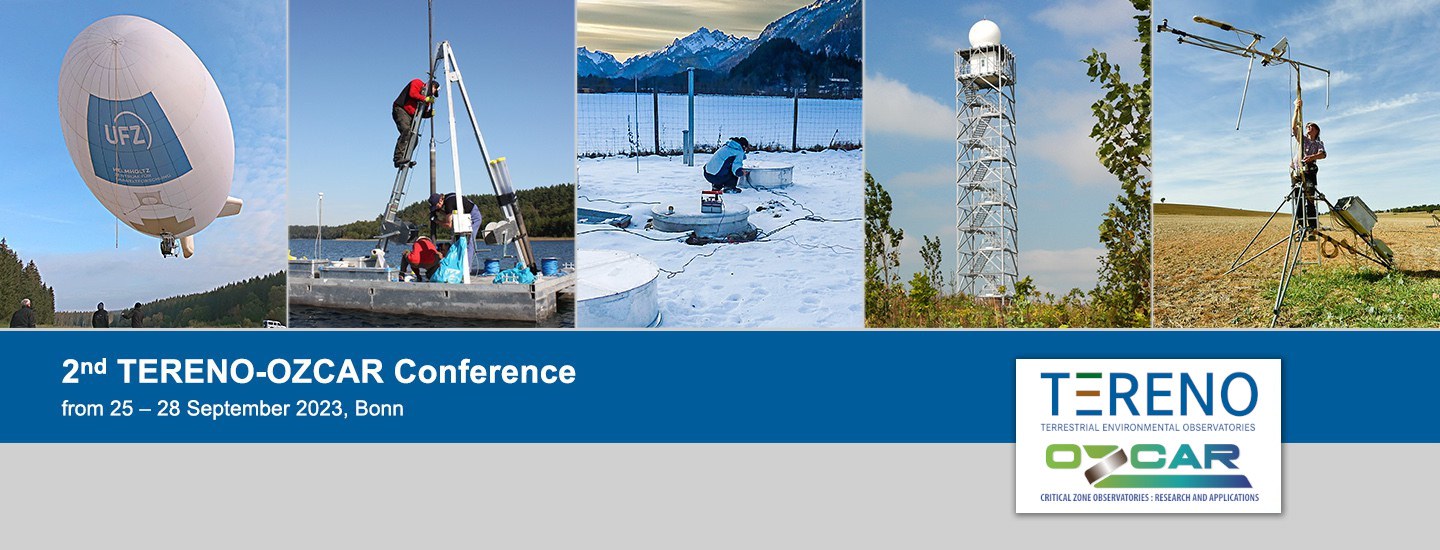Tuesday Poster 26.09.2023
Haoliang Luo - UMR 7619 METIS, Paris, France
Advances and benefits of capillary bundle models: up-scaling approach for predicting electrical conductivity of frozen porous media
Markus Köhli - Heidelberg University, Germany
Cosmic-Ray Neutron Sensing - precision soil moisture measurements at the hectare scale
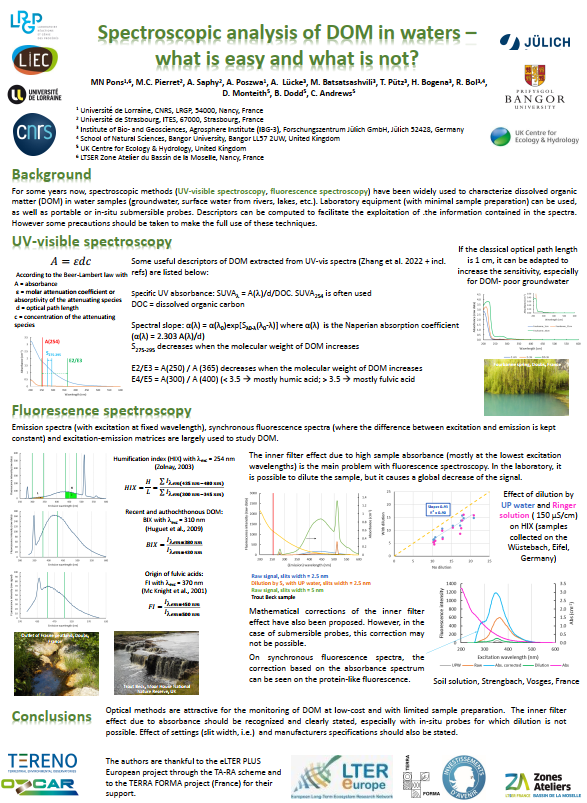
Marie-Noëlle Pons - Université de Lorraine, CNRS, LRG
Spectroscopic analysis of DOM in waters – what is easy and what is not?
Marit Hendrickx - KU Leuven
Autocorrelation in Soil Moisture Sensor Measurement Errors: A Mechanistic Error Modelling Approach
Lasse Hertle - Helmholtz Center for Environmental Research - UFZ
A Practical Approach to Correcting the Incoming Flux Variation for Cosmic Ray Neutron Sensing
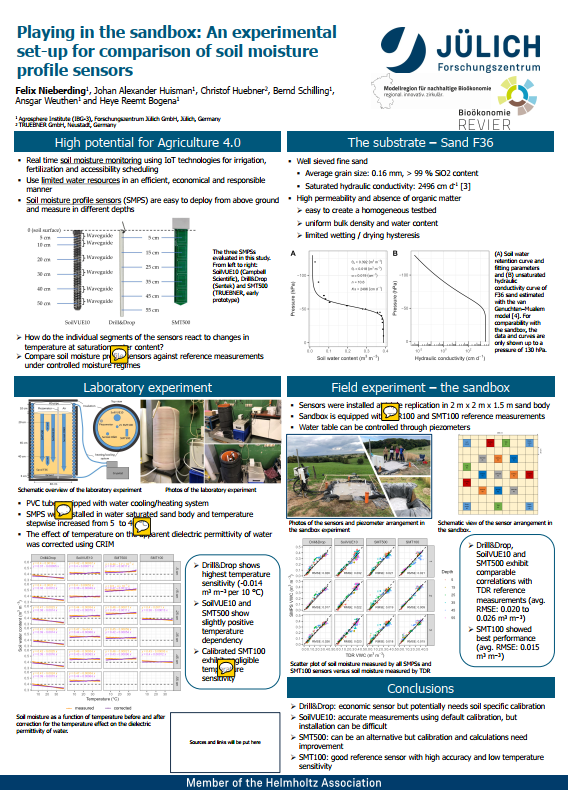
Felix Nieberding - Forschungszentrum Jülich GmbH
Playing in the sandbox: An experimental set-up for comparison of soil moisture profile sensors
Sylvain Pasquet - Sorbonne Université
Using light-weight and autonomous nodal arrays to improve seismic data collection capabilities in steep and rugged-terrain critical zone observatories
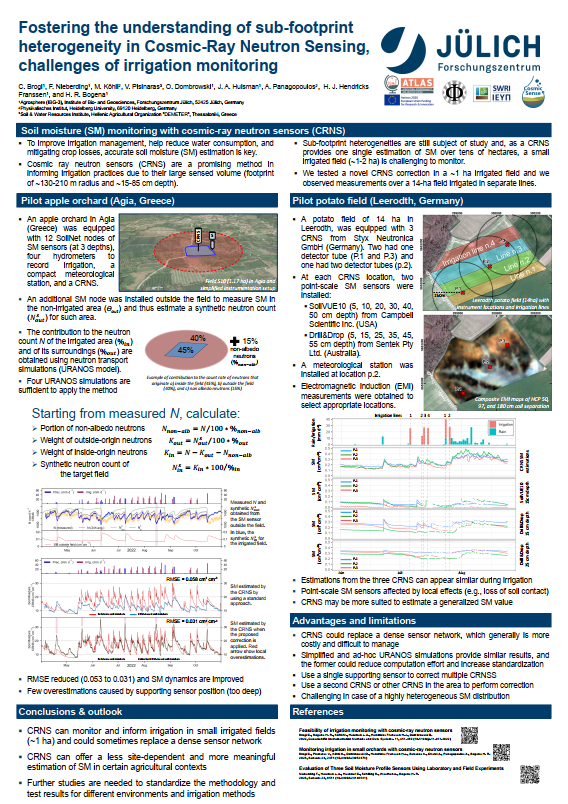
Cosimo Brogi - Forschungszentrum Jülich GmbH
Fostering the understanding of sub-footprint hetero- geneity in Cosmic-Ray Neutron Sensing – challenges of irrigation monitoring
Claudia Voigt - Department of Biology and Geology, University of Almería
The First Continuous Field Record of 17O-excess of Atmospheric Water Vapor: Insights into Local and Regional Atmospheric Processes at a French Medi- terranean Forest Site
Nolwenn Lesparre - Université de Strasbourg, CNRS, EOST, ENGEES
Measuring electrical self-potential in a spruce forest to observe the water exchanges in the subsurface-vegeta- tion-atmosphere continuum
Buse Onay - Forschungszentrum Jülich GmbH
Scientific Discovery in Earth Science Using Deep Learning Technologies
Aram Kalhori - GFZ German Center for Geosciences
Developing temporal phases of GHG emissions in a rewetted peatland site in Germany using long-term ecosystem carbon flux measurements
Farnaz Sharghi - University of Maragheh
Evaluating the long-term relationships between soil water content and evapotranspiration in different soil orders of Iran
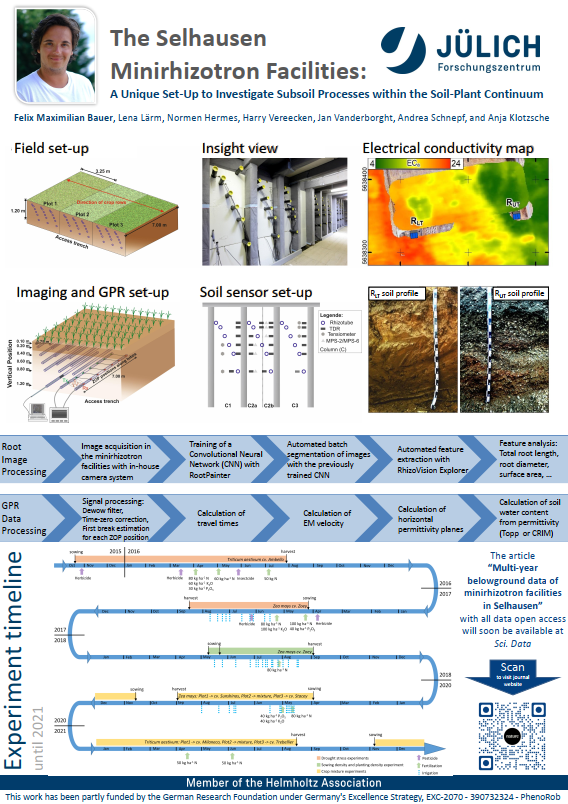
Felix Maximilian Bauer - Forschungszentrum Jülich GmbH
The Selhausen Minirhizotron Facilities: A Unique Set-Up to Investigate Subsoil Processes within the Soil-Plant Continuum
Jannis Groh - Forschungszentrum Jülich GmbH
Using a network of networks for high-frequency multi- depth soil moisture observations to infer spatial and temporal drivers of subsurface preferential flow
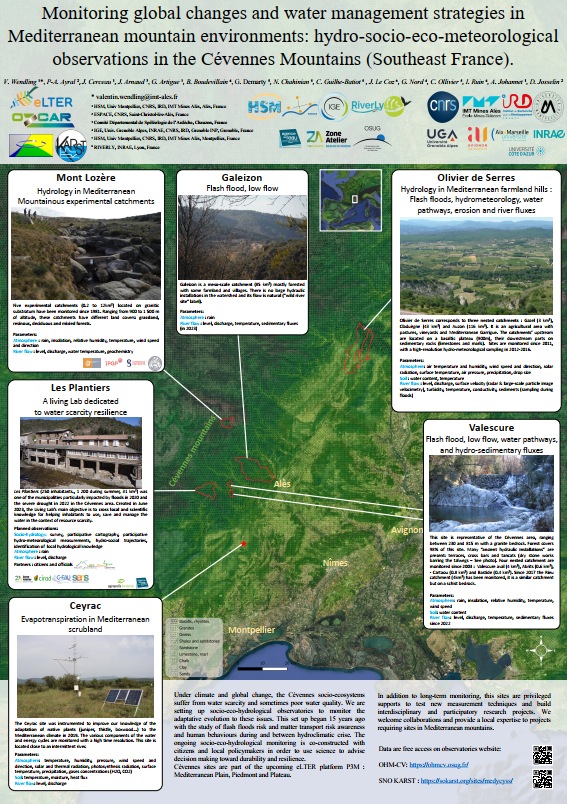
Valentin Wendling - HSM, Univ Montpellier, CNRS, IRD, IMT Mines Alès, Alès, France
Monitoring global changes and water management strategies in Mediterranean mountain environments: hydro-socio-eco-meteorological observations in the Cévennes Mountains (Southeast France)
Olga Tertychna - Institute of Agroecology and Environmental Management of NAAS, Kyiv, Ukraine
Environmental monitoring as a method of environmental quality management
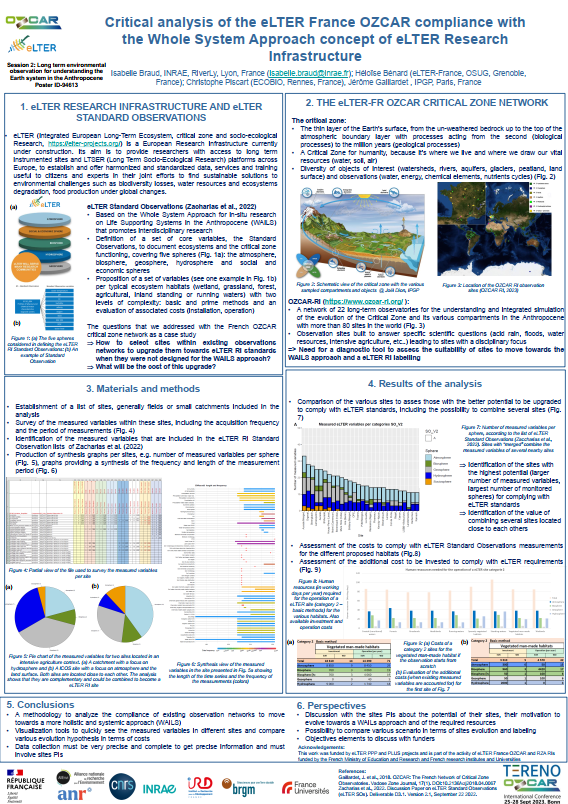
Isabelle Braud - OZCAR-RI, INRAE
Critical analysis of the eLTER France compliance with the Whole System Approach concept of eLTER Research Infrastructure
Alix Toulier - Université de La Réunion
The Critical Zone observatory of Réunion island (France): a multidisciplinary observatory of the tropical Critical Zone in a basaltic volcanic setting
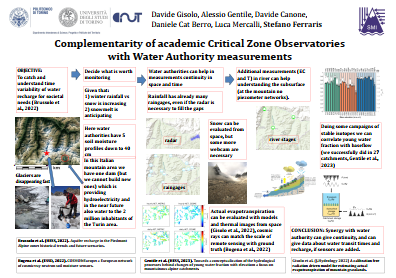
Stefano Ferraris - DIST Politecnico and Università of Turin, Italy
Complementarity of academic Critical Zone Observatories with Water Authority measurements
Laurent Gourdol - Luxembourg Institute of Science and Technology (LIST)
Short high-accuracy tritium data time series for assessing groundwater mean transit times and storages in the vadose and saturated zones of the Luxembourg Sand- stone aquifer
Christophe Hissler - Luxembourg Institute of Science and Technology (LIST)
Opening questions on identifying water sources to trees: application of a multi tracer approach
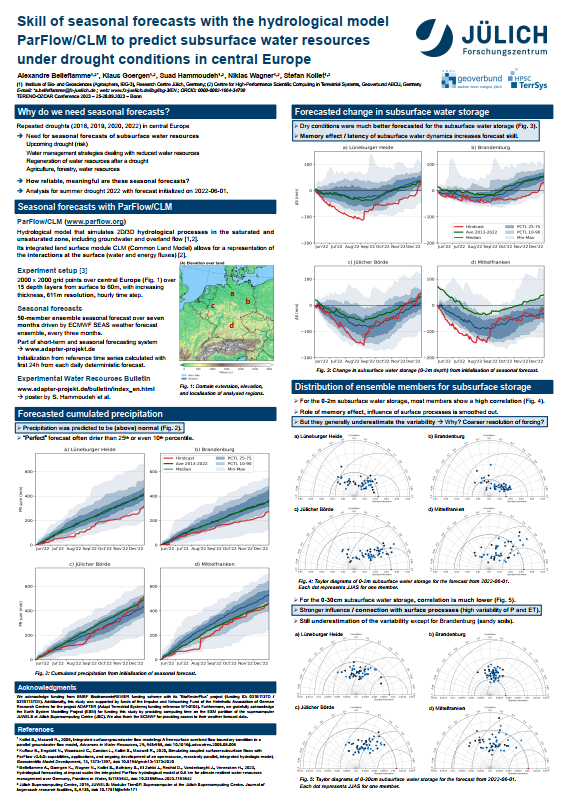
Alexandre Belleflamme - Forschungszentrum Jülich GmbH
Evolution of the subsurface water storage under drought conditions at catchment scale in central Europe with the hydrological model ParFlow/CLM
Agnès Rivière - Mines Paris PSL
How Groundwater Models Can Benefit from Near-Surface Seismic Data?
Alban de Lavenne - INRAE - Institut Agro, UMR SAS, Rennes
Comparative analysis of water storage dynamics for two OZCAR observatories using SAS functions and a GR conceptual hydrological model
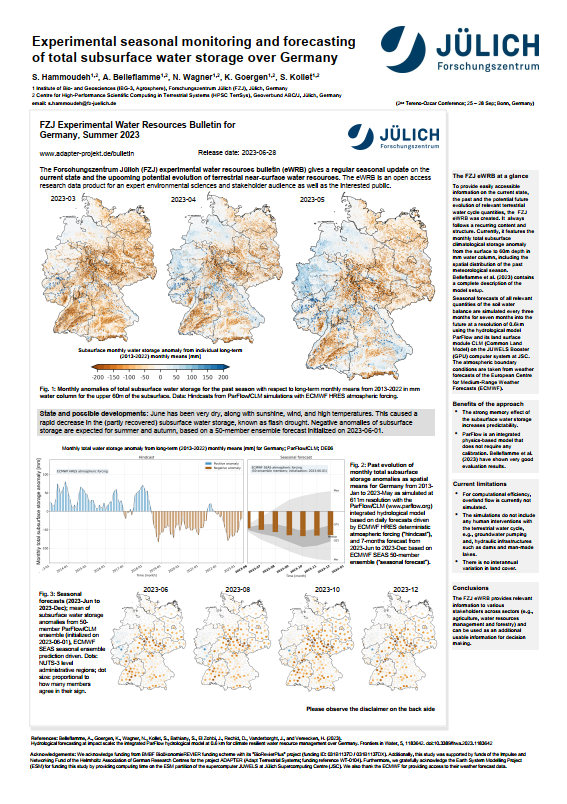
Suad Hammoudeh - Forschungszentrum Jülich GmbH
Experimental seasonal monitoring and forecasting of total subsurface water storage over Germany: The FZJ Water Resources Bulletin
Roland Bol - Forschungszentrum Jülich GmbH
Land use and land cover change effects on runoff in Rur Basin, Germany
Theresa Blume - GFZ German Research Center for Geosciences
Stress responses in the deep unsaturated zone: a forested catchment vulnerable to climate change
Daniel Rasche - GFZ German Research Centre for Geosciences
Exploring greater depths: Cosmic-Ray Neutron Sensing as a tool for downhole soil moisture estimation
Lijie Zhang - Forschungszentrum Jülich GmbH
Revision of states and fluxes from an energy imbalance perspective in a coupled LES and land surface model
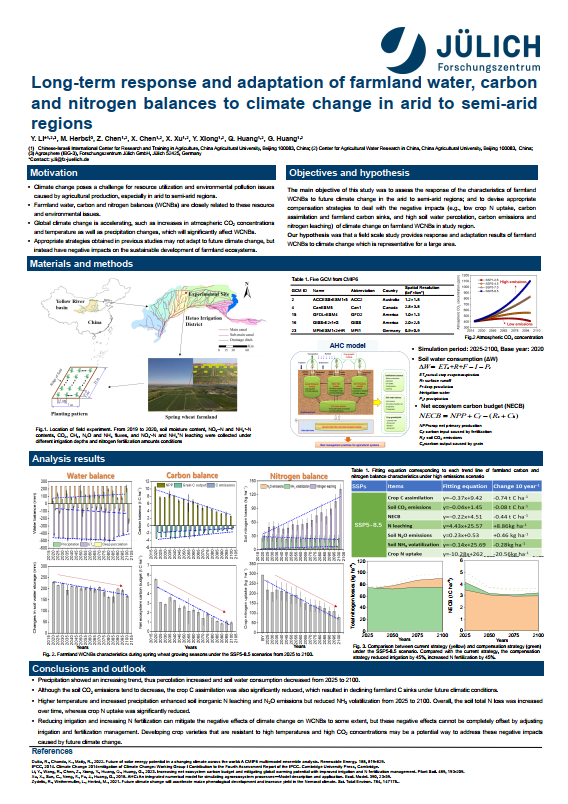
Yue Li - Forschungszentrum Jülich GmbH
Long term response and adaptation of farmland water, carbon and nitrogen cycles to climate change in arid regions
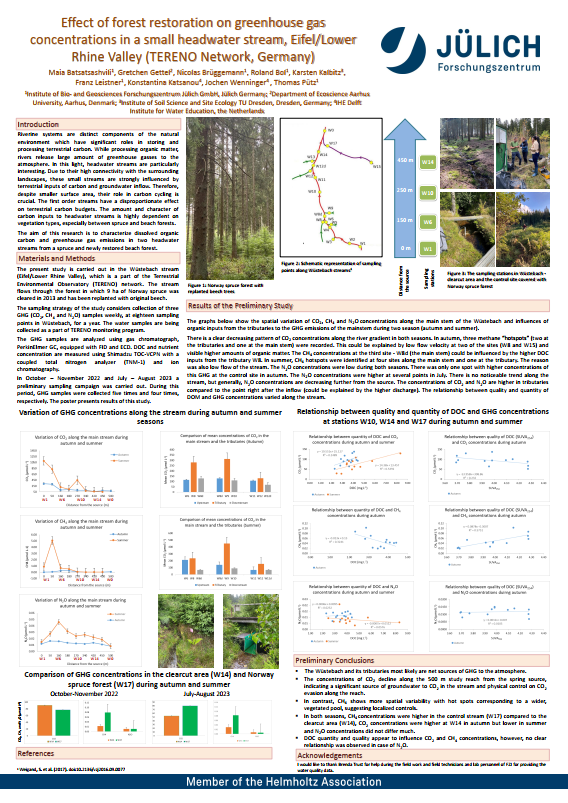
Maia Batsatsashvili1 - Forschungszentrum Jülich GmbH
Effect of forest restoration on greenhouse gas emissions from a small headwater stream, Eifel/Lower Rhine Valley (TERENO Network, Germany)
Fernand Baguket Eloundou - Forschungszentrum Jülich GmbH
Identifying Sources of Uncertainties in Simulated CLM5 Ensemble Simulations
Yikui Zhang - Forschungszentrum Jülich GmbH
Linking the atmospheric water cycle and land-atmos- phere coupling from fully coupled TSMP simulations through a novel atmospheric moisture analysis framework
Christophe Peugeot - HydroSciences Montpellier (HSM), Université de Montpellier, CNRS, IRD, IMT-Mines Alès
The possible perverse effects of water reservoirs for irrigation as a drought adaptation solution: a feedback loop analysis
Jean-Martial Cohard - University Grenoble Alpes
Micro-Wave scintillometry to measure evapotranspi- ration at landscape scale : Evaluation from two field campaigns
Wednesday Poster 27.09.2023
Jie Gu - Forschungszentrum Jülich GmbH
Controls on soil dissolved organic carbon along the 4000 km North-South forest transect in Eastern China
Thibault Lambert - INRAE - Institut Agro, UMR SAS, Rennes, France
Does nitrate regulate dissolved organic carbon mobilisa- tion in wetland soils and its export towards stream water in agricultural catchments?
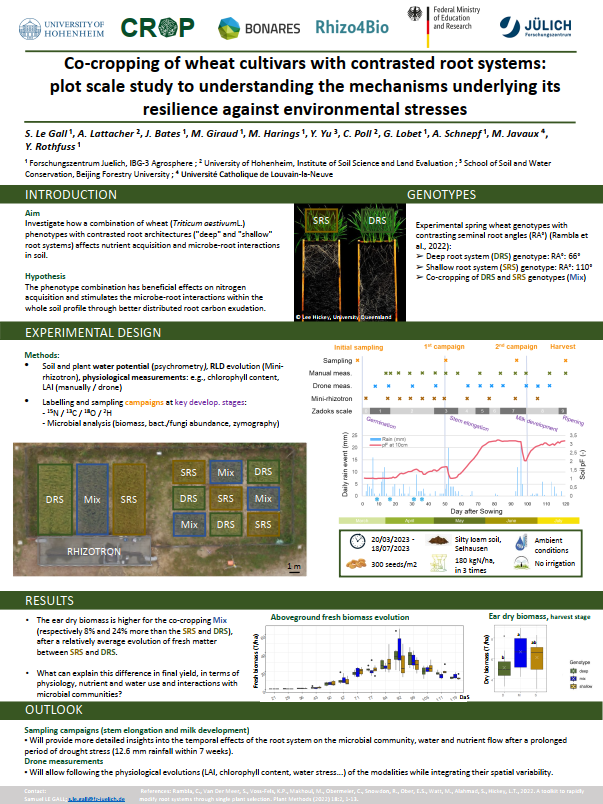
Samuel Le Gall - Forschungszentrum Jülich GmbH
Co-cropping of wheat cultivars with contrasted root sys- tems: plot scale study to understanding the mechanisms underlying its resilience against environmental stresses
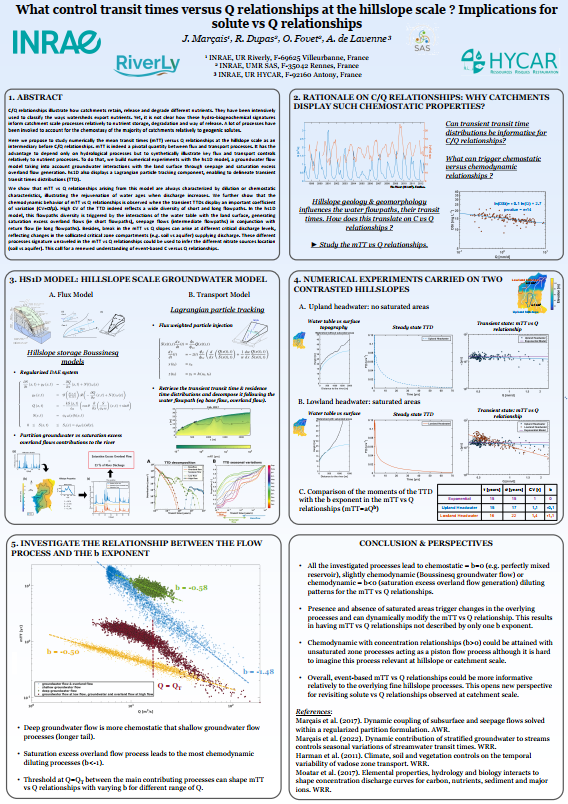
Jean Marcais - INRAE RiverLy
What control transit times versus Q relationships at the hillslope scale ? Implications for nitrate vs Q relationships
Simon Zitzmann - University of Augsburg, Institute of Geography
Elevation-dependent warming and its climatic drivers: A concerted field and modeling assessment for the Berchtesgaden National Park
Guillaume Peugnet - IPGP, IGN, Paris University, France
The impact of subsurface life on ghost-rock karstification processes and cave formation
Susanne Liebner - GFZ, Potsdam
Role of the microbiota for soil transformation processes in arid and semiarid regions under simulated humidity
Sylvian Kuppel - IRD Géosciences Environnement Toulouse
Disantengling hydrological and geochemical drivers of rock-water-plant interactions: a case study with a process-based modelling environment
Ivan Osorio-Leon - University of Rennes – CNRS, Géosciences Rennes, UMR 6118, Rennes
Mineral substrate and fluid redox conditions control cell density in attached biofilms: in-situ incubation experiments in deep groundwater
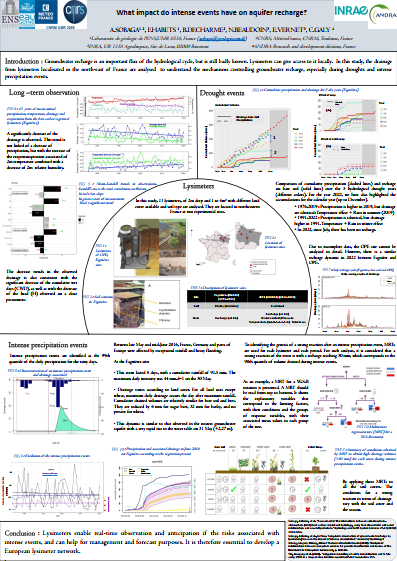
Antoine Sobaga - ENS
What impact do intense events have on aquifer recharge?
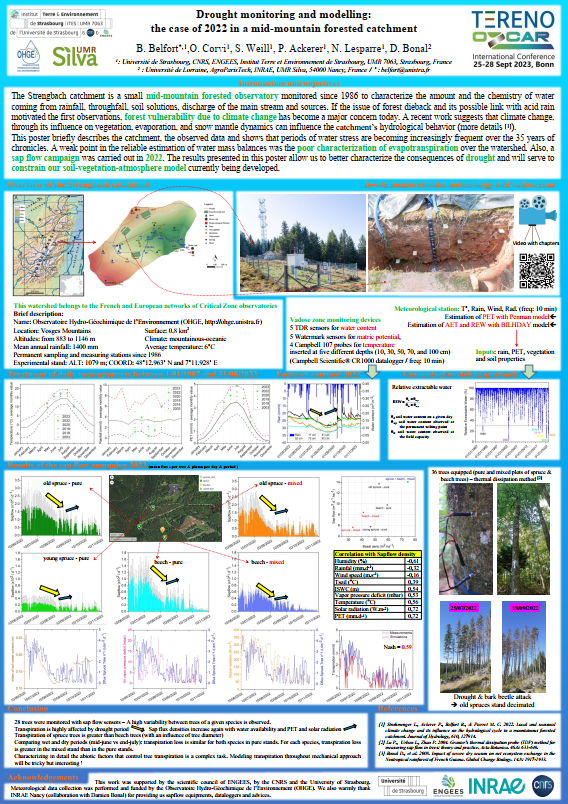
Benjamin Belfort - Université de Strasbourg, CNRS, ENGEES, Institut Terre et Environnement de Strasbourg, UMR 7063
Drought monitoring and modelling: the case of 2022 in a mid-mountain forested catchment
Vazken Andréassian - INRAE
Do piezometric levels impact catchment-scale rainfall yield?
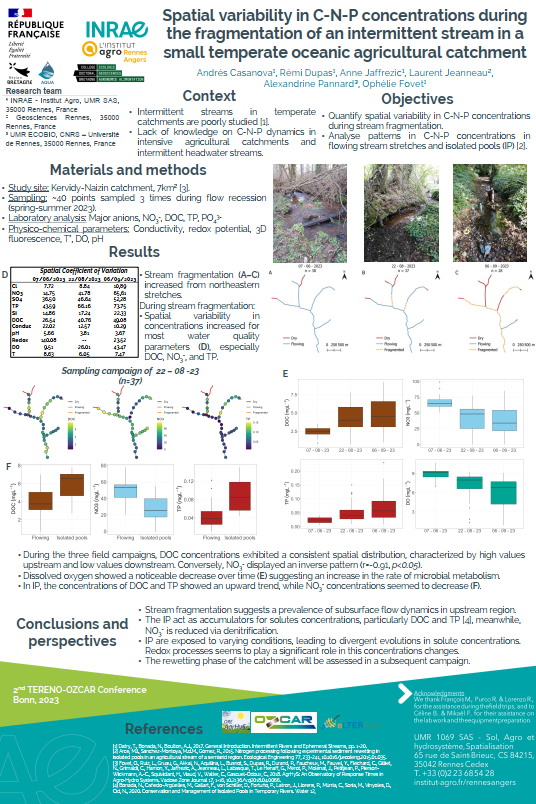
Andrés Casanova - INRAE - Institut Agro, UMR SAS, Rennes, France
Spatial variability of C-N-P concentrations during the fragmentation and rewetting of an intermittent stream in a small temperate oceanic agricultural catchment
Clarissa Glaser - University of Bonn
Groundwater-surface water dynamics in a headwater stream: exploring the influence of varying streamflow using a multitracer approach
Martin Schrön - UFZ – Helmholtz Centre for Environmental Research GmbH
Neptoon – a Neutron Processing Tool for Python
Nikita Basargin - DLR – Deutsches Zentrum für Luft- und Raumfahrt
Soil Moisture Estimation from Multi-dimensional SAR Data
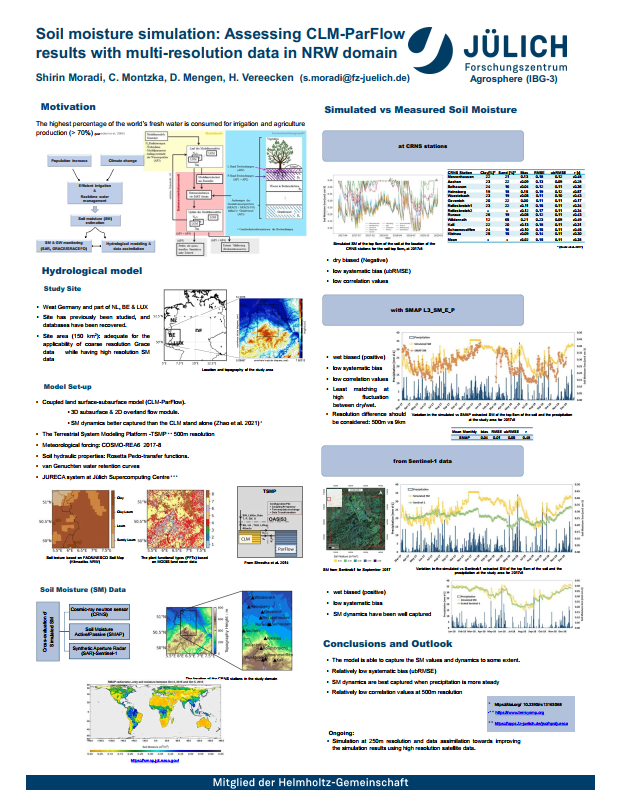
Shirin Moradi - Forschungszentrum Jülich GmbH
Simulating soil moisture for sustainable irrigation: Integrating CLM-ParFlow model with multi-resolution data in the NRW domain
Omar Marigo - Universite Cheikh Anta Diop
Spatio-temporal Analysis of Surface and Root Zone Soil Moisture Derived from SMAP and SMOS Microwave Satellite Data Using in-situ Measurements in Senegal
Jordan Bates - Forschungszentrum Jülich GmbH
Unmanned Aircraft Systems (UAS) Evapotranspiration Estimates Evaluated in Comparison with TERENO Eddy Covariance Measurements
Rahul Raj - Forschungszentrum Jülich GmbH
Retrieval of high-resolution Leaf Area Index maps from PlanetScope data
Chala Chimdessa Goshel - Sinana Agricultural Research Center
GIS based identification of water harvesting potential area in the Bale lowlandof south eastern Ethiopia
Yohannes Ginting - University of Bonn, Institute of Geosciences, Department of Meteorology
Comparison of the gross primary productivity of the FLUXNET towers and remote sensing based models in Borneo island, Southeast Asia
Amande Roque-Bernard - IPGP/CNRS
Suspended sediment transport in small and steep catchments
Rajina Bajracharya - Forschungszentrum Jülich GmbH
Modelling nitrogen and soil water balance with AgroC-N to aid biomass productivity at erosion-affected arable sites along a hummocky landscape
Thanh Quynh Duong - Helmholtz Centre for Environmental Research – UFZ
Modeling carbon and nitrogen turnover in groundwater along a hill slope transect
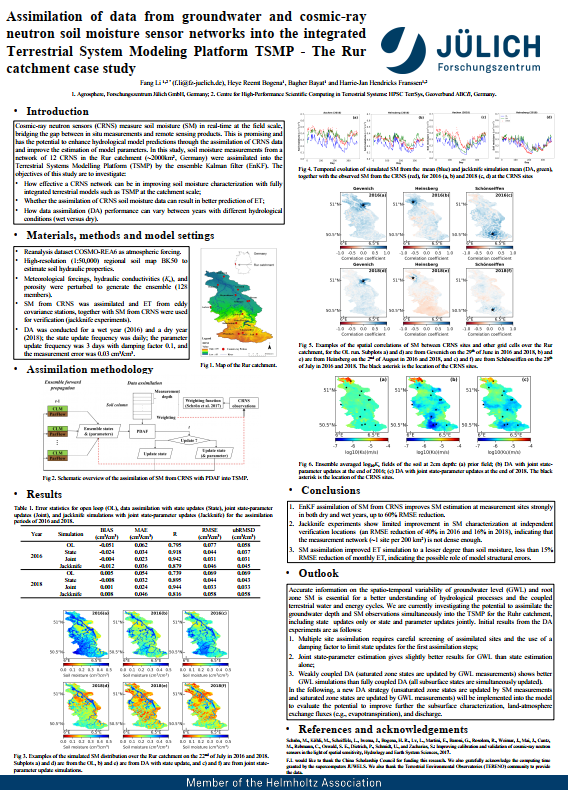
Fang Li - Forschungszentrum Jülich GmbH
Assimilation of data from groundwater and cosmic-ray neutron soil moisture sensor networks into the inte- grated Terrestrial System Modeling Platform TSMP – The Rur catchment case study
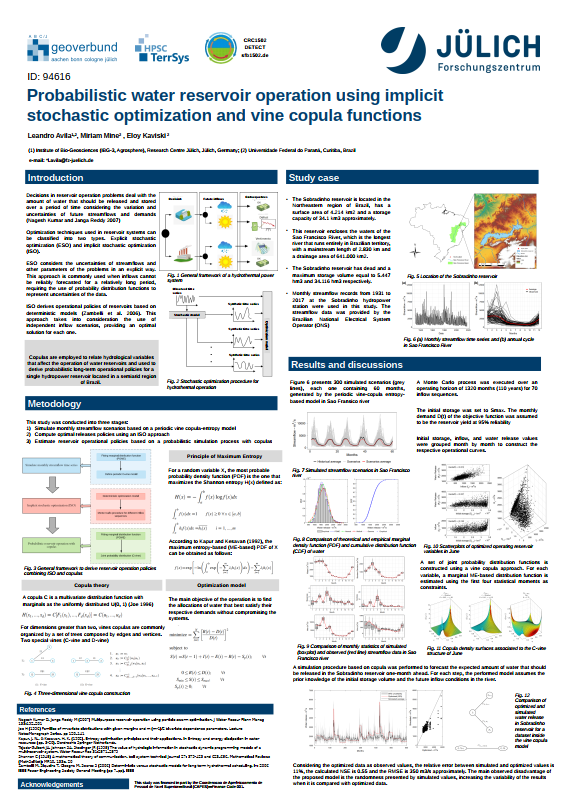
Leandro Avila - Forschungszentrum Jülich GmbH
Probabilistic water reservoir operation using implicit stochastic optimization and vine copula functions
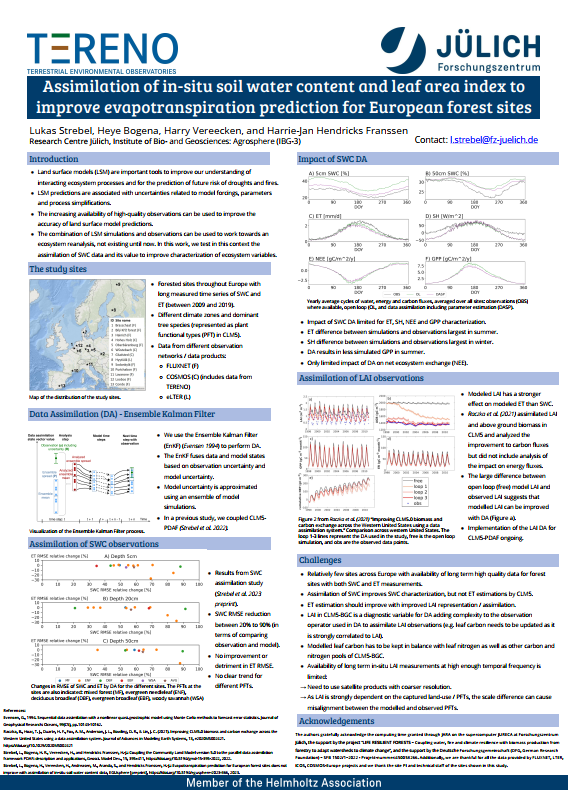
Lukas Strebel - Forschungszentrum Jülich GmbH
Assimilation of in-situ soil water content and leaf area index to improve evapotranspiration prediction for European forest sites
Akokponhoue Bertrand - National Institute of Water (INE), University of Abomey-Calavi (Benin)
Contribution of geoinformatics and geophysics in the prospection of groundwater reservoirs in hard-rock areas
Elodie Robert - CNRS/LETG
Characterization of the E. coli environment in surface waters of West Africa
Christine Vallet-Coulomb - Aix Marseille Univ, CNRS, IRD, INRAE, CEREGE, Aix-en-Provence
Monitoring the isotopic composition (17O-excess, d-excess and d18O) of precipitation in Northern Benin: insights on climate variations
Diego Chavez-Espinoza - Aix-Marseille Univ., CNRS - IRD - INRAE - CEREGE
Large-scale tracer-aided hydrological modeling of West African basin
Mathias Tidjani - Université Catholique de Louvain, Earth and Life Institute (ELI)
Systematic synthesis of knowledge relating to the hydro- logical functioning of inlands valleys in tropical Africa
Jan Bliefernicht - Uni Augsburg
Exploring and Closing the Energy Balance of Eddy Covariance Measurements along a Land Use Gradient in the West African Sudanian Savanna
Tuesday Sessions 26.09.2023
Keynotes
Dörthe Tetzlaff, Humboldt Universität zu Berlin
Enhancing monitoring and modelling of water storage dynamics
Kevin Bishop, Swedish University of Agricultural Sciences (SLU), Uppsala
Marie-Elodie Perga, University Lausanne
Building upon multiple-scale observatories to delineate the sources and mechanisms of CO2 emissions from lakes
Daniela Vanella, Università degli Studi di Catania
Session: Innovative sensing and analysis methods for environmental research
Sonia Akter, Forschungszentrum Jülich GmbH
Assessing the accuracy of root-zone soil moisture prediction from gamma radiation monitoring data
Nurit Agam, Ben-Gurion University of the Negev
Martin Schrön, UFZ - Helmholtz Centre for Environmental Research GmbH
Spatiotemporal soil moisture monitoring with cosmic rays in TERENO, Central Germany
Luca Stevanato, Finapp srl
Self-referenced Cosmic Rays Neutron Sensing probes based on contextual muons detection
Patrick Davies, KNUST
Optimal Temporal Filtering of the Cosmic-Ray Neutron Signal to Reduce Soil Moisture Uncertainty
Francis E. Oussou, Federal University of Technology Akure
Improving the depth-to-bedrock maps for groundwater-to-atmosphere modeling in Africa
Daniel Schulz, Forschungszentrum Jülich GmbH
Inge Wiekenkamp, GFZ German Center for Geosciences
Airborne eddy covariance for estimating regional turbulent matter and energy fluxes in NE Germany
Antoine Lucas, IPGP/CNRS
Mapping Critical Zone biomass and surface roughness with a backpack LiDAR
Ulrike Werban, UFZ - Helmholtz Centre for Environmental Research GmbH
Marie-Noëlle Pons, Université de Lorraine
Effect of clear-cutting on the dissolved organic matter in the Wüstebach catchment
Christoff Andermann, Université Rennes
Automated high resolution water sampler
Session: Measuring and modelling water storage dynamics
Jayson Gabriel Pinza, University of Antwerp
Jordy Salmon-Monviola, INRAE - Institut Agro, UMR SAS
Improving the internal hydrological consistency of a process-based solute transport model by simultaneous calibration of stream concentration and water flow
Julien Ackerer, IGE grenoble & OZCAR RI
Integrated and ecohydrological modeling of the water cycle in three contrasting long term observatories (OZCAR network, France)
Aniket Gupta, University of Grenoble Alpes
Modeling global warming impacts on Rain/snow partitioning, water path, and residence time in a mid-elevation mountain catchment
Mathilde de Fleury, Université Toulouse
Hydrological regime of Sahelian small water bodies from combined Sentinel-2 MSI and Sentinel-3 SRAL data
Olga Dombrowski, Forschungszentrum Jülich GmbH
Fabrice Rodriguez, Campus Nantes - Univ Gustave Eiffel
Session: Long-term environmental observation for understanding the Earth system in the Anthropocene
Paolo Nasta, University of Naples
Exploring soil water dynamics in the Alento hydrological observatory
Xiao Lu, Forschungszentrum Jülich GmbH
Analysis of Scale-dependent Spatial Correlations of Actual Evapotranspiration Measured by Lysimeters
Laura Nadolski, Max-Planck Institute for Biogeochemistry, Jena
Jannis Groh, Forschungszentrum Jülich GmbH
Do we know our soil‘s water cycle well?
Gerhard Helle, GFZ German Center for Geosciences
Differentiated response of pine and oak to air quality changes and recent drought in rural Northeastern Germany
Wolfgang Korres, Federal Institute of Hydrology (BfG)
Wednesday Sessions 27.09.2023
Keynotes
Cathy Hohenegger, Max Planck Institute for Meteorology, Hamburg
Representation of the water cycle and its coupling to the land surface in a kilometre-scale Earth System Model
Jantienne Baartman, Wageningen University
Modelling the dynamics of sediment and associated substances across temporal and spatial scales
Julian Klaus, University of Bonn
Daniella Rempe, University of Texas at Austin
Observing interactions between tree roots, minerals, and fluids in a shale critical zone and implications for weathering and landscape evolution
Session: Biogeochemical processes at the soil and catchment scale
Valentine Rollot, Université Paris Cité
Microbial biofilms structure and manganese (bio)cycling: from field to lab studies
David Uhlig, Freie Universität Berlin
Imbalances in dissolved elemental export fluxes disclose “hidden” Critical Zone pathways
Nicolaus van Zweel, Luxembourg Institute of Science and Technology
Claudia Schütze, UFZ - Helmholtz Centre for Environmental Research GmbH
Temporal and spatial pattern of riverine greenhouse gas emissions in a large temperate river
Andreas Musolff, UFZ - Helmholtz Centre for Environmental Research GmbH
High-frequency concentration-discharge relationships of nitrate and dissolved organic carbon reveal altered nutrient mobilization during forest dieback
Qiqi Wang, Forschungszentrum Jülich GmbH
Annemarie Bäthge, UFZ - Helmholtz Centre for Environmental Research GmbH
Michael Rode, UFZ - Helmholtz Centre for Environmental Research GmbH
Rémi Dupas, INRAE - Institut Agro, UMR SAS
Nitrate and phosphorus export dynamics during the extreme storm events of the future
Session: Water and biogeochemical cycles in Earth system models
Yves Godderis, Geosciences Environnement Toulouse, GET, CNRS, UMR5563
The role of the thickness of the regolith cover on the Earth climate stability
Filip Kiałka, Ecole Normale Supérieure & CNRS
Composite models of soil hydraulic properties for representing soil (de)compaction in land surface models
Liubov Poshyvailo-Strube, Forschungszentrum Jülich GmbH
Groundwater in terrestrial systems modelling: a new climatology of extreme heat events in Europe
Mehdi Rahmati, Forschungszentrum Jülich GmbH
Soil Moisture Memory Mitigates or Amplifies Drought Effects
Christophe Peugeot, HydroSciences Montpellier (Université de Montpellier, CNRS, IRD, IMTMines Alès)
A drought-triggered hydrological tipping point in the central Sahel: an attribution study using system dynamics modelling
Session: Extremes and the critical zone: Water and matter transport during floods and droughts, intermittent streams and processes at the groundwater-surface water interface
Ophélie Fischer, Univ. Grenoble Alpes, CNRS, Institut des Geosciences de l‘Environnement (IGE)
Study of the contribution of groundwater to floods in Mediterranean mountainous watershed
Cécile Delcourt, Univ. Grenoble Alpes, CNRS, Institut des Geosciences de l‘Environnement (IGE)
Fine sediments deposition and remobilisation processes in a mesoscale mountain catchment
Gareth Old, UK Centre for Ecology & Hydrology
Floods and droughts research infrastructure (FDRI): enabling the hydrological research community
Maxime Savatier, ANDRA
Monitoring large fluctuations of dissolved oxygen in intermittent streams with significant groundwater-surface interactions
Guilherme Emidio Horta Nogueira, UFZ - Helmholtz Centre for Environmental Research GmbH
Konstantina KatsanouI, HE Delft Institute for Water Education
Seasonal and spatial variations of physicochemical parameters in headwater catchments to define groundwater input – Wüstebach Catchment, Germany
Thursday Sessions 28.09.2023
Keynotes
Nick van de Giesen, Delft University of Technology
TEMBO Africa: Seven sensors, five products, three services
Frank Hagedorn, Swiss Federal Institute for Forest, Snow and Landscape Research WSL, Birmensdorf
Mountain ecosystems in a changing climate
Anna Balenzano, Consiglio Nazionale delle Ricerche, NaplesEarth
Observation data for high resolution soil moisture monitoring
Philippe Peylin, LSCE, Saint-Aubin
Francoise Genova, Observatoire de Strasbourg
Science data sharing – feedback from other communities: the case study of astronomy
Session: Biogeochemical processes at the soil and catchment scale
Ralf Kiese, KIT - Karlsruhe Institute of Technology
Impact of climate and management on grassland yields in the pre-alpine region of South Germany
David Gateuille, EDYTEM – CNRS / Université Savoie Mont Blanc
Influence of hydrological regime on soil-to-river pollutant fluxes in alpine areas
Sylvain Kuppel, Géosciences Environnement Toulouse, University of Toulouse, CNRS - IRD - UPS - CNES
Michael Dannenmann, KIT - Karlsruhe Institute of Technology
Session: Novel methods for the integration and exploration of environmental data
Martin Abbrent, UFZ - Helmholtz Centre for Environmental Research GmbH
Building Scalable Time Series Data Infrastructures: State-of-the-Art Solutions for Accessible and Interoperable Environmental Data
Sylvain Grellet, BRGM, Bureau de Recherches Géologiques et Minières, Orléans
OneWater FAIR Data Platform: setting up a national FAIR water dataplatform and community
Ulrich Loup, Forschungszentrum Jülich GmbH
A General Approach to Unbundle a Largely Monolithic Time-Series Management System
Hervé Squividant, Institut Agro / INRAE - UMR SAS Rennes
SOFAIR - A tool for publishing observation data within an ecosystem of interoperable services
Charly Coussot, Université Grenoble Alpes, IRD, CNRS, Météo-France, INRAE, OSUG
Sami Miaari, Forschungszentrum Jülich GmbH
A machine learning framework to design basin specific drought indexes
Session: Challenges in understanding Critical Zone processes in Africa
Jean-Martial Cohard, Institute of Geosciences and Environment, Univ. Grenoble Alpes, CNRS, IRD
AMMA-CATCH observatory: a portal for regionalizing eco-hydro-climatic observations in West Africa
Jan Bliefernicht, Augsburg University
Souleymane Sy, Augsburg University
Land-based mitigation options for climate change in West Africa: Results from WRF-NoahMP-Hydro high-resolution simulations
Chloé Ollivier, HydroSciences Montpellier (HSM), Univ Montpellier
Session: Remote sensing for improved analysis of soil-vegetation-atmosphere dynamics at the regional scale
Toni Schmidt, UFZ - Helmholtz Centre for Environmental Research GmbH
Gridded Profile Soil Moisture through Artificial Intelligence
Thomas De Almeida, Univ. Grenoble Alpes, INRAE, CNRS
Mapping vegetation evolution in badlands in response to climate and erosion using aerial and satellite imagery
Nesrine Farhani, HydroSciences Montpellier (HSM), Univ Montpellier, CNRS, IRD
Estimation of evapotranspiration in Sahelian regions from space: review and uncertainty analysis
Thierry Pellarin, Institut des Géosciences de l‘Environnement (IGE)
Use of nadir altimetry data to evaluate a continental hyper-resolution simulation over West Africa
Quentin Beauclaire, TERRA, Gembloux AgroBioTech - Université de Liège
Session: Model data fusion: Improving model prediction and process understanding
Simon De Cannière, Forschungszentrum Jülich GmbH
Marit Hendrickx, KU Leuven
Samira Sadat Soltani, Forschungszentrum Jülich GmbH
Multivariate data assimilation for improving subsurface storage estimates: A case study of The Upper Rhine Basin
Théo Mazure, INRAE CARRTEL
Marcio Dos Reis Martins, Agroscope
Nitrous oxide emissions and N leaching from permanent grasslands in Western Europe: assessing the impact of management using DayCent
Hao Chen, Tianjin University
A data-driven framework for assembling multiple geoscientific models
Second TERENO-OZCAR International Conference 2023 in Bonn, Germany
In October 2021, we organized the first joint meeting of OZCAR, the French research infrastructure on “Observatoires de la Zone Critique” and TERENO, “Terrestrial Environmental Observatories” in Straßbourg, France. It was the first meeting of this kind in Europe aiming at bringing together scientists active in terrestrial system’s research. This meeting was extremely well received as the place to be where critical zone research in Europe meets.

Following up on this success, it was decided to organize a second international joint meeting in Bonn, the former capital of the Federal Republic of Germany. The conference program covered 10 main subject areas – from fundamental questions on exchange processes between soil, vegetation and atmosphere, to the use of data and different approaches to long-term observation, to new measurement methods and modeling approaches. Some 170 researchers from about 20 countries attended the conference in Bonn and roughly, 50 additional participants attended the conference online. More than 80 oral presentations and 70 poster presentations brought participants up to date on the latest developments in Critical Zone research.
An excursion to the TERENO test site Wüstebach and a conference dinner on the Rhine cruise ship Moby Dick complemented the conference. In addition, Franco-German research and science cooperation and related funding and financing programs were presented and discussed at a special event hosted by Samuel Pujade-Renaud of the French Embassy in Germany.
You can find the program of the conference here.
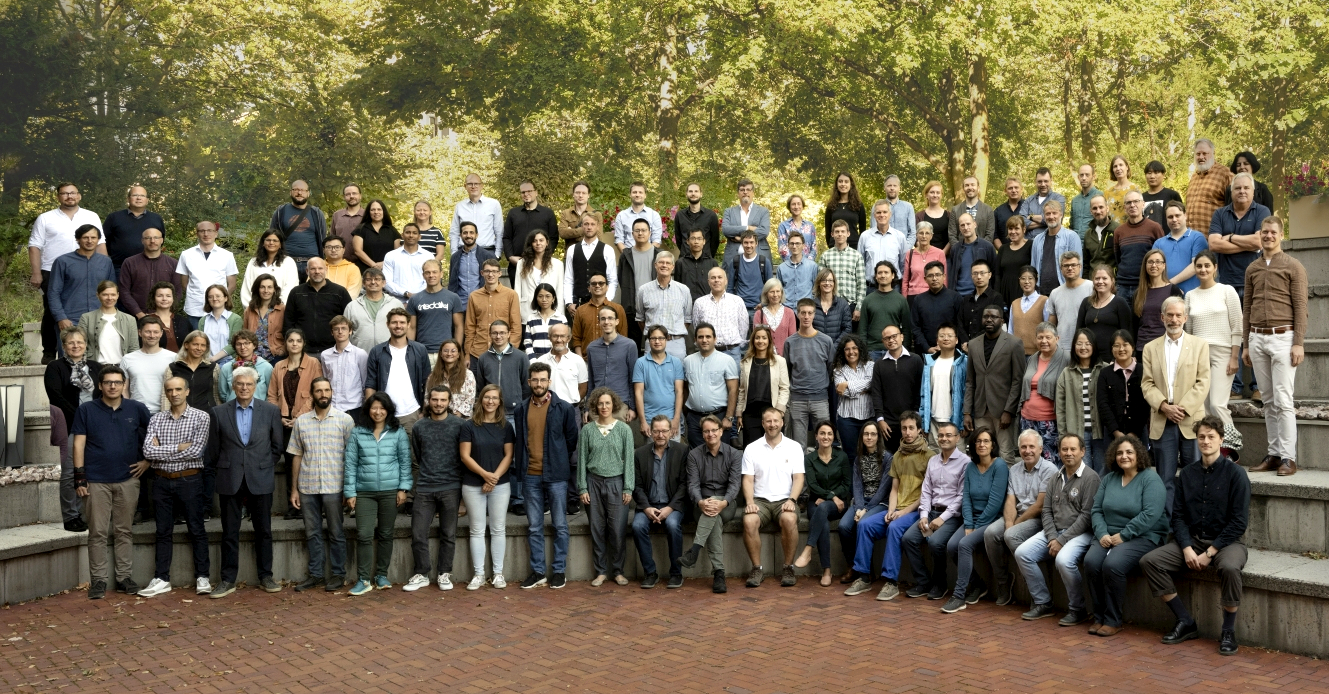
Articles, reports and newsstories




